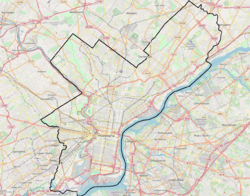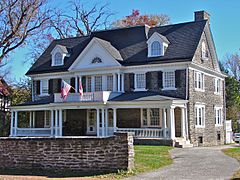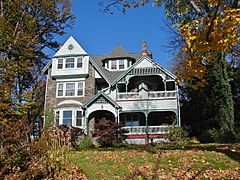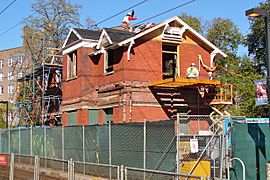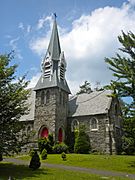Tulpehocken Station Historic District facts for kids
The Tulpehocken Station Historic District is a special neighborhood in the Germantown area of Philadelphia, Pennsylvania. It's known for its many large, old houses built between about 1850 and 1900. These homes show off different styles from that time, like Carpenter Gothic, Italianate, and Victorian. This historic district was added to the National Register of Historic Places in 1985. It covers about six city blocks, bordered by McCallum Street, the Pennsylvania Railroad tracks, Tulpehocken Street, and Walnut Lane. Many of its buildings are considered important parts of history.
Quick facts for kids |
|
|
Tulpehocken Station Historic District
|
|
 |
|
| Location | Roughly bounded by McCallum St., W. Walnut Ln., Penn Central RR tracks, and W. Tulpehocken St., Philadelphia, Pennsylvania |
|---|---|
| Area | 80 acres (32 ha) |
| Architect | Multiple |
| Architectural style | Late 19th and 20th Century Revivals, Late Victorian |
| NRHP reference No. | 85003564 |
| Added to NRHP | November 26, 1985 |
Contents
Exploring Historic Architecture
The Tulpehocken Station Historic District is like a living museum of old building styles. Many homes here were built during a time when people loved to make houses look like they belonged in a beautiful painting. This was part of something called the Picturesque Movement.
Popular House Styles
You can see several interesting architectural styles in this neighborhood:
- Carpenter Gothic: Imagine a house that looks a bit like a fancy, small castle, but made of wood. It often has pointed arches and decorative trim.
- Italianate: These houses often have low-pitched roofs with wide eaves (the part that hangs over the walls). They might have tall, narrow windows and sometimes a cupola (a small dome on the roof).
- Bracketed: This style uses decorative brackets, which are supports that stick out from under the eaves or window sills. They add a lot of detail to the outside of the house.
- High Victorian: As time went on, around the 1870s, styles became even more detailed and grand. High Victorian homes are often very decorative with lots of different textures and shapes.
- Second Empire: This style is easy to spot because of its special roof, called a mansard roof. It's a four-sided roof with a double slope on each side, often with dormer windows sticking out.
Important Buildings to See
The district has many important buildings. Out of 155 buildings, 37 are considered very significant. Here are some of the most famous ones:
Historic Homes
- Kimball House: Located at 144 West Walnut Lane, this house was built in 1860. It's a great example of the early styles in the area.
- Ebenezer Maxwell House: Found at 200 West Tulpehocken Street, this house was built in 1859. It's now a museum that shows what life was like in the Victorian era.
- Mitchell House: This home at 200 West Walnut Lane was built around 1856. It's another early and important house in the district.
- Van Dyke Residence: Built around 1860 at 150 West Walnut Lane, this house also shows the popular styles of the time.
Community Landmarks
- St. Peter's Episcopal Church of Germantown: Located at 6000 Wayne Avenue, this beautiful church was built in 1873. It's a key part of the neighborhood's history.
- Tulpehocken Station: The train station at 314 West Tulpehocken Street was built in 1878. It's not just a station; it's a historic building that gave the district its name!


